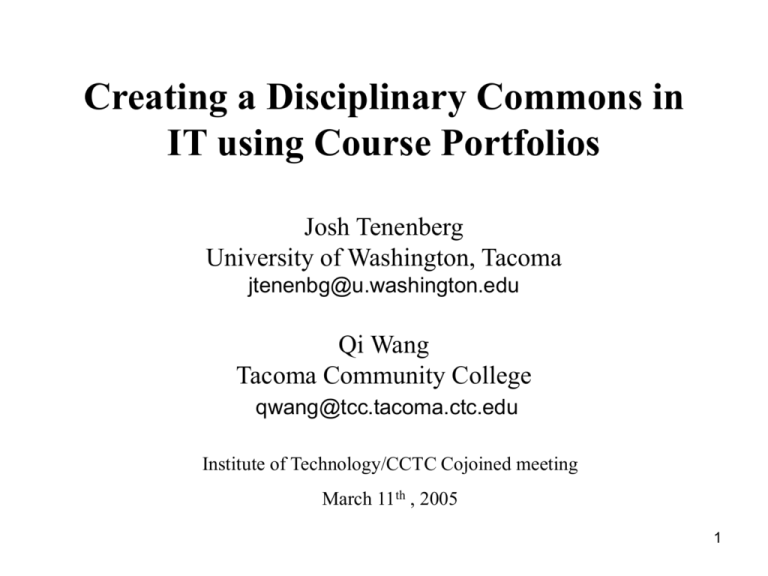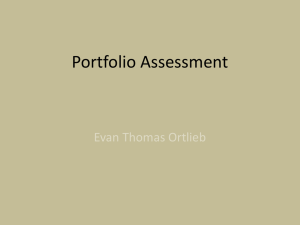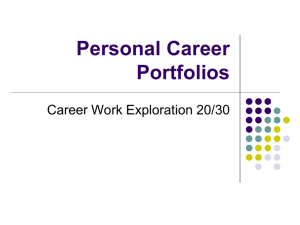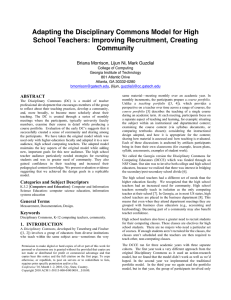Creating a Disciplinary Commons in IT using Course Portfolios
advertisement

Creating a Disciplinary Commons in IT using Course Portfolios Josh Tenenberg University of Washington, Tacoma jtenenbg@u.washington.edu Qi Wang Tacoma Community College qwang@tcc.tacoma.ctc.edu Institute of Technology/CCTC Cojoined meeting March 11th , 2005 1 Disciplinary Commons: Program Objectives • to document and share knowledge about student learning on courses in Information Technology (IT) in two- and four-year institutions in Washington state. • to improve the quality of teaching in IT within Washington state by establishing practices for the scholarship of teaching by making it public, peerreviewed, and amenable for future use and development by other IT educators 2 Disciplinary Commons: Program Structure • Meetings between ~15 IT faculty from CTC’s and 4year universities in South Puget Sound initial, full-day, Sept 05 one afternoon/month Oct-May 0506 capstone, full-day, June 06 • Sessions focused on Course Portfolios, peer review and collaboration • Each participant completes Course Portfolio, critiques others’ • Peer observation of one another's classrooms 3 An Opportunistic Pilot Study • Qi Wang (TCC): Faculty Fellowship, winter 2005 • Josh and Qi wrote their own portfolios - discussed our portfolios as we developed them Qi: Intro to Programming Josh: Software Development 4 Interaction Patterns • Our role as peer reviewers was not a matter of evaluating whether we liked or didn't like the other's work. Rather, our goal was to give the other person information that would help them to improve their teaching and to more clearly convey the characteristics of the course about which they were writing, 5 Interaction Pattern • Course portfolios are created in a hyperlinked format and posted on the Internet • Meet weekly throughout the 10 week term. - 30 minutes – 2 hours per meeting - Discussing our own work “should I link to the syllabus or include excerpts within the portfolio?” “I think that my students need more time to learn about alternative representations for encoding algorithms” 6 Interaction Pattern - Discussing the work of the other person. Comments on material, the purpose and goal of an assignment. “Why don't you use consistent language throughout all of the documents given to students in describing each of the phases of the software development lifecycle” 7 Interaction Pattern • WHY questions – most fruitful • Questions that brought us deeper into the other person's reasons for designing and enacting their course in their unique way. • Questions that highlight the disciplinary nature of teaching, even, or perhaps particularly, in the introductory levels. “Why do you teach flowcharting?” “Why do you use a guided demonstration to teach levels of nesting rather than have students work in small groups?” 8 Contents of our Portfolios * Purpose and Audience * Course Objectives * Curricular Context * Course Design * Course Enactment * Rationale * Student Outcomes * Historical Trajectory and Future Directions * Acknowledgements * Bibliography * Appendices 9 Rationale: Teaching as a Design Activity • The Design Rationale is arguably the most important part of the portfolio • This rationale is what Dorst (Understanding Design, 2003) calls “the story behind [the design] ... It is the justification of the design, which explains why the design is constructed in just the way it is.” 10 Characteristics of Design Problems • • • • • • Distribution of Information Nature of Constraints Size & Complexity Component Parts Interconnectivity of parts Right & Wrong answers • • • • • Input/Output Feedback loop Cost of errors Independent functioning Distinction between specification & delivery • Temporal separation The Structure of Design Problem Spaces Vinod Goel and Peter Pirolli. Cognitive Science 16 (1992) 395-429 (slide from Sally Fincher, University of Kent at Canterbury, UK) 11 Rationale: Folk Pedagogies • The rationale reveals our “folk pedagogies” about learning, both in general and in the discipline. “our interactions with others are deeply affected by our everyday intuitive theories about how other minds work. ... “Watch ... any teacher ... and you'll be struck by how much of what they do is steered by notions of ‘what the children's minds are like and how to help them learn,’ even though they may not be able to verbalize their pedagogical principles.” (Bruner, The Culture of Education, 1996) • Constructing a course portfolio helps one to verbalize taken-for-granted beliefs about thinking and learning. 12 Qi’s Lessons • Not all students know what and how to learn. Integrate lessons on navigating the textbooks and breaking large problems into smaller, manageable subproblems along with the discipline-specific content. • Not all of the pair programming that she uses works as well as she thought. Although students indicate a preference for those with matching schedules, there might be a mismatch in learning styles. Instead, she will try to devote more time for pair programming in the scheduled labs. • Demonstrating new concept using simpler example may be beneficial to student’s learning. - use single level instead of nesting level example to demonstrate the alternative programming tools. - have students work in small groups instead of guided demonstration. 13 Josh’s Lessons • Students dedicate significant effort to their project, and maintain group commitment throughout the term, though there is a range in the effectiveness with which the groups work. • Though students might engage in several of the software practices while in class session (CRC cards, unit testing), there is little evidence that students will transfer these skills beyond the bounds of this course and into their other courses and their professional lives. 14 Lessons Learned about the “Commons” project • This project helped us to become considerably more sensitive to the contextual constraints under which we each work • We gained increased respect and admiration for one another's skills and passion for student learning at our partner institutions. • Writing a portfolio is considerably aided when done with at least one peer, particularly in revealing our folk pedagogies • Our respective courses are at too far a distance from the interface between our institutions to give sufficient insights into “the institutional gap” that students have to bridge in going from the community college to the 4-year university. 15 Dissemination • We will present our work at the SoTL showcase, April 05, UW Seattle • We are submitting our paper to CCSCNW for presentation (Oct 05) and publication • We might submit a paper to the IS-SoTL conference in Vancouver, Oct 05. 16 Update on “Commons” Project for 2005-06 year • Hinges on funding (one-course release/year per participant) and participant commitment • Josh is funded and committed, subject to final signoff from CSS program and UWT • There are tentative commitments from one colleague at each of PLU and UPS • Discussions with SBCTC for one-course release for 6 or 7 CTC participants is continuing, and there are positive indications • Funding is being sought for 1 or 2 others in CSS to participate 17






